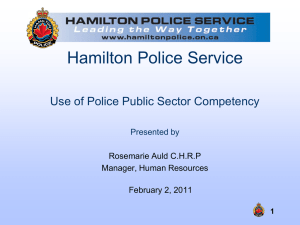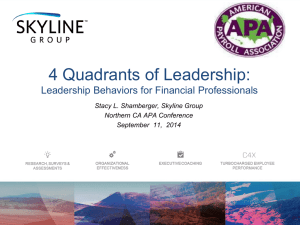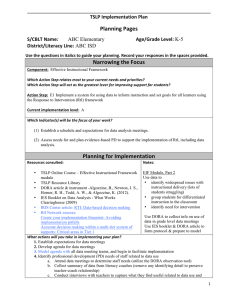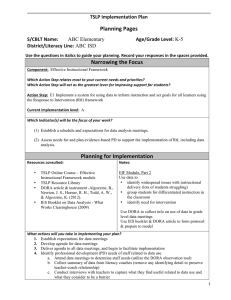Chapter 13: Competency-Based Language Teaching Pages 141-148
advertisement
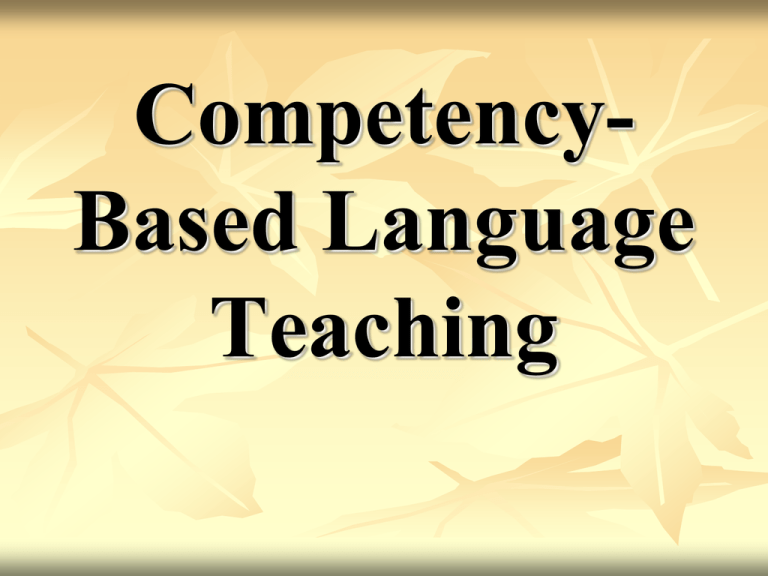
CompetencyBased Language Teaching Competency: Essential skill, knowledge or behaviour required for effective performance of a real world task or activity. Background CBE (Competency-Based Education) Emerged in the U.S in 1970s For immigrants and refugees An educational movement Focusing on the outputs and outcomes of learning rather than inputs To the competencies perspective, outputs to learning is central Differences between CBE and other methods Other methods Input centered Syllabuses, materials, activities Changing the role of the learners and teachers So, more effective language learning occurs CBE Output centered No matter how the language learning occurs What are expected from students (output) CBE Described by Schenk 1978 . Performance based instruction Individualized instruction Mastery learning Outcome based Adaptive to the changing needs Competency-Based Language Teaching(CBLT) By the end of 1970s… Work-related and survival-oriented language teaching programs for adults. The most important breakthrough in adult ESL 1990s “The state-of-the-art approach to adult ESL by national policymakers and leaders in curriculum development as well”. 1986 Refugees in the U.S had to be enrolled in a competency-based program. Programs based on specific skills needed for individuals Advocates of CBLT see it as a powerful agent of change. Because; Opportuinty for teachers to revitalize their education and training programs Quality of assessment and teaching improves Student learning is enhanced Specification of expected outcomes Continuous feedback Standards Movement since 1990s Glaser and Linn states: “..The national educational standards emerged…” Washington D.C.-based center for Applied Linguistics under control to the TESOL organization- developed the K-12 school standards for ESL. They divided the grade levels into clusters: Pre-K to 3rd grade 4th to 8th grade 9th to 12th grade CBLT in Britain in 1980s Sharing features of the graded objectives movement proposed as a framework for organizing foreign language teaching Graded objectives are; series of short-term goalsbuilded upon one before. One of the most remarkable events in modern language learning in UK. CBLT in general: the principles of CBE educational movement focuses on outcomes of learning Work-related and survival-oriented learning The learners: refugees, immigrants the most important breakthrough in adult ESL teacher’s opportunity to revitalize their education programs Teaching quality enhances The aim is that the students’ being master of specific language skills to function proficiently in the society Approach: Theory of Language and Learning CBLT (Competency Based Language Teaching) is based on functional and interactional perspective language is taught in social context Has in common with behaviorist views Language can be analyzed into parts and subpart and they can be tested incrementally. “mosaic” approach develops functional communication skills in learners, known of specific real-world task. Design:Objectives, Syllabus, Learning activities, Role of Learners, Teachers, and Material Docking(1994) Syllabus Start with field of knowledge Subject based content and syllabus Objectives Assessment based on norm referencing Recieving marks for performances CBLT designed not around the notion of subject knowledge but around the notion of competency Focuses on what students can do with language not what they know about language. Instead of norm-referenced assessment, criterion-based assessment procedures are used in which learners are assessed according to how well they can perform on specific learning tasks. (tells us how well students are performing on specific course or standards rather than just telling how their performance compare to group of students) Competency consists of knowledge attitudes, behaviors, for reals tasks and activities HOW CBLT WORKS Teacher: first carries out a needs analysis to see how and where the students will need to use their English. defines some competencies (tasks) that the students will need to accomplish. For example, giving personal information, filling a form, making a doctor’s appointment, applying for work, and so on. creates activities that will teach the students how to accomplish those competencies (tasks). Finally evaluates the students on their ability to perform those tasks. Competencies consist of activities related with the real life situations for surviving social environment. ESL curriculum for immigrant and refugees include: Task performance Safety General word-related Work schedules, times sheets, paychecks Social language Job application Job interview Competencies for retaining a job: Follow instructions to carry out a simple task Respond appropriately to supervisor’s comments Request supervisor to check work Report completion of task to supervisor Request supplies Follow oral directions to locate an object Follow simple oral directions to locate a place Read charts, labels, forms or written instructions to perform a task State problem and ask for help if necessary State amount and type of work already competed. Respond appropriately to work interruption or modification Docking’s relationship between competencies and job performance a unit of competency A role, function, task or learning module Change over time, show difference from context to context An element of competency any quality or characteristic of and individual specific knowledge, attidutes,thinking process,perceptual and physical skills independent of context and time building block Mid-nineteenth century Spencer in1860: The major areas of human activity as the basis for curricular objectives. Bobbitt in 1926: curricual objectives related to his analysis of functional competencies required for adults in U.S . Northrup’s report in 1977: Five knowledge areas Four basic skill areas 65 competencies Auerbach in 1986: Eight key features in the implementation of CBE programs in ESL: A focus on successful functioning in society Autonomus learners A focus on life skills Language as a function of communication Task-or performance-centered orientation What a person can do rather than what he knows Modularized instruction objectives are broken into narowly focused subobjectives Outcomes that are made explicit a priori specifying in terms of behavioral objectives Continuous and ongoing assessment Students’ being pretested and posttested Demonstrated mastery of performance objectives assesment relying on demonstration of the behaviours Individualized, student-centered instruction Objectives acording to students needs, prior learning, no time based instruction Advantages of CBE for learners Specific and practical judged by learners specific and public can be mastered one at a time Procedure Australian Migrant Education Program One of the largest immigrant language training program. Moved from centralised planing (content-based and structural curriculum) to decentralised learnercentered (needs-based) More recently to the competency-based curriculum frameworks. Certificate in Spoken and Written English Learning outcomes are specified in three stages Stages 1 and 2 relate to General language development Stage 3 relates: Grouping learners according to their goal focus and competencies Competencies defined by three syllabus Further Study Vocational English Community Access Advanced Certificate in Spoken and Written English These three stages lead to Stage 4: Advanced Certificate in Spoken and Written English. Students are placed according to their: English proficiency level Learning pace Needs Social Goals for learning English The Competency descriptions 1)Knowledge and learning competencies 2)Oral competencies 3)Reading competencies 4)Writing competencies Competencies described in terms of Elements breaking down competency into smaller components and linguistic features Performance criteria Range of variables setting limit for competency peformanc Sample texts and assessment tasks providing examples of texts and tasks CONCLUSION Embraced with enthusiasm Criticised practically and philosophically No valid procedures available Impossibility of applying needed competencies (adult living, survival, functioning proficiently in the community) Sum of the parts is not equal to the whole (reductionist approach) Banking Model The function of education is: Socializing learners according to their dominant socioeconomic group Transmitting the knowledge Teacher’s job is to create ways to teach skills. Prescriptivist in that teaching focuses on behavior and performance rather than on the development of thinking skills CBLT is gaining strength internationally. As Rylatt and Lohan said: ‘’It can confidently be said, as we enter a new millennium, that the business of improving learning competencies and skills will remain one of the world’s growing industries and priorities’’. Thank you for your attention!..






